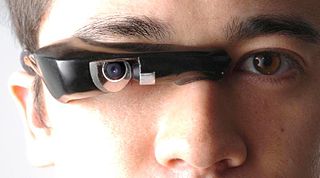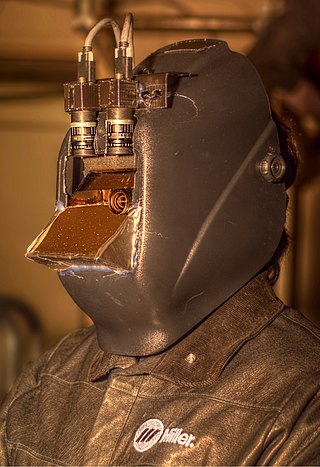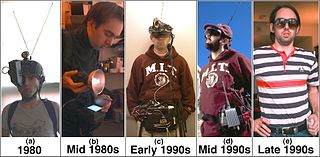
A wearable computer, also known as a body-borne computer, is a computing device worn on the body. The definition of 'wearable computer' may be narrow or broad, extending to smartphones or even ordinary wristwatches.

Sousveillance is the recording of an activity by a member of the public, rather than a person or organisation in authority, typically by way of small wearable or portable personal technologies. The term, coined by Steve Mann, stems from the contrasting French words sur, meaning "above", and sous, meaning "below", i.e. "surveillance" denotes the "eye-in-the-sky" watching from above, whereas "sousveillance" denotes bringing the means of observation down to human level, either physically or hierarchically.

An EyeTap is a concept for a wearable computing device that is worn in front of the eye that acts as a camera to record the scene available to the eye as well as a display to superimpose computer-generated imagery on the original scene available to the eye. This structure allows the user's eye to operate as both a monitor and a camera as the EyeTap intakes the world around it and augments the image the user sees allowing it to overlay computer-generated data over top of the normal world the user would perceive.

Computer-mediated reality refers to the ability to add to, subtract information from, or otherwise manipulate one's perception of reality through the use of a wearable computer or hand-held device such as a smartphone.

Gesture recognition is an area of research and development in computer science and language technology concerned with the recognition and interpretation of human gestures. A subdiscipline of computer vision, it employs mathematical algorithms to interpret gestures.
Equiveillance is a state of equilibrium, or a desire to attain a state of equilibrium, between surveillance and sousveillance. It is sometimes confused with transparency. The balance (equilibrium) provided by equiveillance allows individuals to construct their own cases from evidence they gather themselves, rather than merely having access to surveillance data that could possibly incriminate them.

Light painting, painting with light,light drawing, light art performance photography, or sometimes also freezelight are terms that describe photographic techniques of moving a light source while taking a long-exposure photograph, either to illuminate a subject or space, or to shine light at the camera to 'draw', or by moving the camera itself during exposure of light sources. Practiced since the 1880s, the technique is used for both scientific and artistic purposes, as well as in commercial photography.
High dynamic range (HDR), also known as wide dynamic range, extended dynamic range, or expanded dynamic range, is a signal with a higher dynamic range than usual.

A hydraulophone is a tonal acoustic musical instrument played by direct physical contact with water where sound is generated or affected hydraulically. The hydraulophone was described and named by Steve Mann in 2005, and patented in 2011. Typically, sound is produced by the same hydraulic fluid in contact with the player's fingers. It has been used as a sensory exploration device for low-vision individuals.

Humanistic Intelligence (HI) is defined, in the context of wearable computing, by Marvin Minsky, Ray Kurzweil, and Steve Mann, as follows:
Humanistic Intelligence [HI] is intelligence that arises because of a human being in the feedback loop of a computational process, where the human and computer are inextricably intertwined. When a wearable computer embodies HI and becomes so technologically advanced that its intelligence matches our own biological brain, something much more powerful emerges from this synergy that gives rise to superhuman intelligence within the single “cyborg” being.

Lifestreaming is an act of documenting and sharing aspects of one's daily experiences online, via a lifestream website that publishes things of a person's choosing.

A lifelog is a personal record of one's daily life in a varying amount of detail, for a variety of purposes. The record contains a comprehensive dataset of a human's activities. The data could be used to increase knowledge about how people live their lives. In recent years, some lifelog data has been automatically captured by wearable technology or mobile devices. People who keep lifelogs about themselves are known as lifeloggers.

Posthuman or post-human is a concept originating in the fields of science fiction, futurology, contemporary art, and philosophy that means a person or entity that exists in a state beyond being human. The concept aims at addressing a variety of questions, including ethics and justice, language and trans-species communication, social systems, and the intellectual aspirations of interdisciplinarity.

A cyborg —a portmanteau of cybernetic and organism—is a being with both organic and biomechatronic body parts. The term was coined in 1960 by Manfred Clynes and Nathan S. Kline. In contrast to biorobots and androids, the term cyborg applies to a living organism that has restored function or enhanced abilities due to the integration of some artificial component or technology that relies on feedback.

SixthSense is a gesture-based wearable computer system developed at MIT Media Lab by Steve Mann in 1994 and 1997, and 1998, and further developed by Pranav Mistry, in 2009, both of whom developed both hardware and software for both headworn and neckworn versions of it. It comprises a headworn or neck-worn pendant that contains both a data projector and camera. Headworn versions were built at MIT Media Lab in 1997 that combined cameras and illumination systems for interactive photographic art, and also included gesture recognition.
In computing, a natural user interface (NUI) or natural interface is a user interface that is effectively invisible, and remains invisible as the user continuously learns increasingly complex interactions. The word "natural" is used because most computer interfaces use artificial control devices whose operation has to be learned. Examples include voice assistants, such as Alexa and Siri, touch and multitouch interactions on today's mobile phones and tablets, but also touch interfaces invisibly integrated into the textiles of furniture.

Telepointer is a neck-worn gestural interface system developed by MIT Media Lab student Steve Mann in 1998. Mann originally referred to the device as "Synthetic Synesthesia of the Sixth Sense". In the 1990s and early 2000s Mann used this project as a teaching example at the University of Toronto.

Smartglasses or smart glasses are eye or head-worn wearable computers. Many smartglasses include displays that add information alongside or to what the wearer sees. Alternatively, smartglasses are sometimes defined as glasses that are able to change their optical properties, such as smart sunglasses that are programmed to change tint by electronic means. Alternatively, smartglasses are sometimes defined as glasses that include headphone functionality.

In kinematics, absement is a measure of sustained displacement of an object from its initial position, i.e. a measure of how far away and for how long. The word absement is a portmanteau of the words absence and displacement. Similarly, its synonym absition is a portmanteau of the words absence and position.
Egocentric vision or first-person vision is a sub-field of computer vision that entails analyzing images and videos captured by a wearable camera, which is typically worn on the head or on the chest and naturally approximates the visual field of the camera wearer. Consequently, visual data capture the part of the scene on which the user focuses to carry out the task at hand and offer a valuable perspective to understand the user's activities and their context in a naturalistic setting.

















